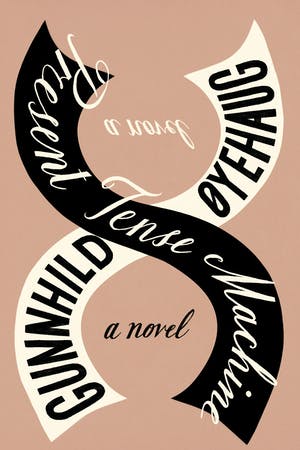Your appreciation of Gunnhild Øyehaugh’s Present Tense Machine, translated by Kari Dickson, will be partially predicated on how much you think about multiverses, or déjà vu, or ever have had the indescribable sense of something missing, in yourself, in others.
What elevates this novel beyond the admittedly fascinating realm of such scientific ruminations is how Øyehaugh uses this construct to explore relationships, identity, and the power of language. Would you be you without those who are integral to your current life? Can the word change the world?
In the first chapter we’re introduced to pregnant, twenty-four year old Laura, married to musician Karl, who are seeking a new home for their expanding family. Twenty years earlier, twenty-three year old Anna is reading poetry by Tua Forsström while her toddler Laura is playing in their garden. She accidentally reads the word “trädgård” (“garden”) as “tärdgård,” (which has no meaning) and in that instant, a parallel path spears off in which there is no Laura, and in Laura’s new plane, no Anna. In her universe, Anna divorces, remarries and has two children, Peder and Elina.
In alternate chapters, we experience these parallel existences, which have some similarities and instances where the two almost come into contact with each other. “Whatever the case, we can safely say there’s little about Laura to indicate that she’s living in a parallel universe created by a misreading. But, in fact: she is…Laura has never quite known how to deal with these forces that somehow feel luminous, as though she were some kind of chosen one who’d been put on earth to do good, only she hadn’t discovered what yet, or how.”
Erik Satie’s “Vexations” plays a role in each of the two narratives, as music that both Laura and Anna have strong feelings about. Encompassing only a single sheet of music (which wasn’t even published in his lifetime), “Vexations” embraced “enharmonic” equivalency, whereby a note, or phrase is similar to another but “spelled” differently. Because of an inscription in the original sheet music, there’s a modern assumption—a misreading, perhaps?—that the piece should be played 840 times. The first marathon session with a slew of pianists seamlessly taking over for each other in relays, was initiated and led by John Cage, one for whom sound and silence, being and non-being, underscore his ethos and oeuvre.
There’s also an omniscient narrator who doesn’t stay in the shadows: “When I say ‘at the time of writing,’ I’m of course referring to myself, not Laura. She’s not writing, I am.” If we’re to believe in this parallel universe, then we can’t help but question who this omniscient voice is. How does it know so much about Anna and Laura, and their multiple lives? How much control does it have of those lives?
So, too, who is the omniscient voice in our lives? And how does it control us as we live unaware, yet sometimes feeling the twinge of what might have been or is, somewhere, somewhere.
Anna thinks: “The Earth Hour: an hour to remember our own mortality. That we will disappear. That we come from the great darkness. That our lives here on earth in the light are framed by absolute pitch-black. That at some random point, which we can do nothing to control, we arise out of the dark, and stumble around in the light for a few decades, until we are once again returned to the dark and disappear as suddenly as we appeared. It would be a good thing to be reminded of this once a year…”
It’s an immensely satisfying experience to read Kari Dickson’s expert translation in which Øyehaugh’s poetic talents soar, and there’s also a delightful irony in reading it in English rather than Norwegian, especially as it’s a story about how a misread word may send us into a wormhole. But doesn’t literature, poetry, language, have the power to change us? Perhaps not a single word, but the accumulations of such, haven’t they changed us, the whole world? More fancifully, does this translation, and my potential misreading, create more parallel universes? And how would I know?
Near the end of the novel, at another marathon relay session of “Vexations”:
“And this is what actually happens: Anna goes over to the grand piano, stands there and waits for the pianist to finish the last chord, and as the previous player slips off to the left, Anna slips in from the right at exactly the same time as Laura. On the same piano stool, only in two different universes, they sit, mother and daughter.”
There’s less of a conclusion—or at least in my case, less of a desire for a concrete conclusion—than a pause where our place in this story ends, where our narrator closes the book on us. Like Satie’s “Vexations,” there are surely more replications that we’re not aware of, in our own lives most of all. Despite lifetime(s) of loss and missed connections, there’s still much to experience and savor. And right now, that feels like an immensely hopeful point, especially with echoes such as this contemplation, this time from Elina, Laura’s unknown half-sister:
“Then it happens again, she gets that feeling. As though Elina is the one who’s going to rescue them all. And she’ll manage, because that is what she’s come here to do in this life, everything is going to be all right, because of her, this is not something she believes, it’s something she knows. Elina shuts her eyes now, and sees herself walking around the room touching everyone’s forehead, without them noticing, and inside herself she says: Saved, saved, saved, saved.”
Regardless of how many parallel universes there are—or because of how many parallel universes there might be—we are always missing someone. We are always lost, in some way. And perhaps the smell of a flowering white lilac, or the sound of Erik Satie’s “Vexations,” or a word one misreads in a garden, will alert us to what may be elsewhere, but isn’t here. What we may be elsewhere, but aren’t here.
May we all live many lives. May we all be saved.

FICTION
Present Tense Machine
By Gunnhild Øyehaugh, translated by Kari Dickson
Farrar, Straus and Giroux
Published January 11, 2022

